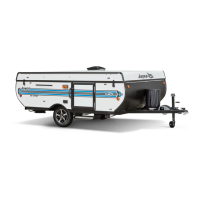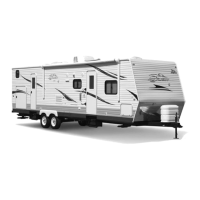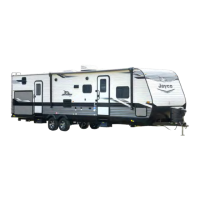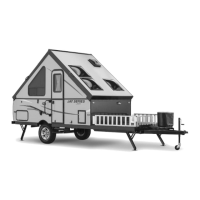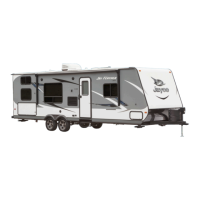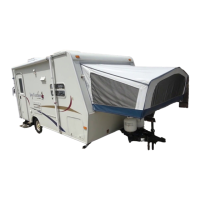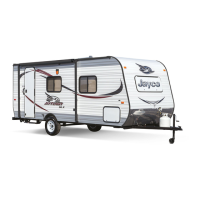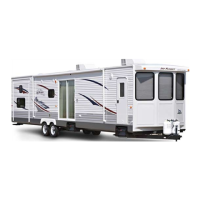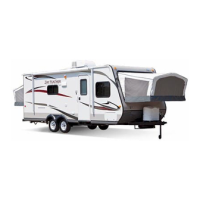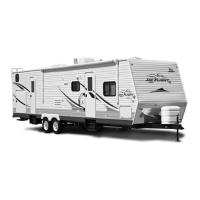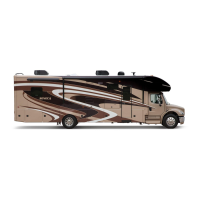Air pressure (all models)
This method will utilize an air hose to blow
excess water from the water lines.
1. Make sure all holding tanks are empty and
drain valves OPEN.
2. Run the water pump (if so equipped) until it
is dry, this will take approximately 15-20
seconds.
3. OPEN all faucets and drains, and the toilet
(if so equipped).
4. Using an air hose and adapter (customer
supplied), blow air through the city water
connection. Any remaining water will blow
out in five to ten minutes.
5. Pour one cup of non-toxic RV antifreeze
into all drain P-traps.
Demand or power plumbing system
It may be easier to winterize the RV with
another person to assist you.
1. Level the RV and drain the fresh water
plumbing system by opening the low point
drain valves (V3 & V4). If your model has a
permanently mounted fresh water tank,
open the “fresh tank drain” valve, too.
2. If so equipped, replace the water filter
cartridge with the clear plastic bypass
hose.
3. If so equipped, make sure the water heater
12-volt and 120-volt interior control
switches are OFF.
4. Close the “fresh tank drain” and low point
drains valves (V3 & V4).
5. Close valve V1 to prevent RV antifreeze
from entering the fresh water tank.
6. Open valve V2 and insert the siphon hose
into a container of RV antifreeze solution
(this quantity should be enough to
winterize the RV).
7. If so equipped, turn the water pump ON.
8. Open the hot water line on all the faucets
until RV antifreeze begins to flow
continuously.
9. Close the faucet hot water lines and repeat
with the cold water lines on all the faucets.
Do not forget to run RV antifreeze through
the cassette toilet (if so equipped).
When you are done adding RV antifreeze
10. Remove the siphon hose from the
container of RV antifreeze.
11. To prevent staining, wipe the RV
antifreeze out of the sinks, shower (or tub)
and toilet using a soft, dry cloth.
To reduce the chance of contamination,
prevent the garden hose from coming into
contact with the ground. If needed, contact
your RV dealer for assistance.
BLACK/GREY WATER SYSTEM
(IF SO EQUIPPED)
Water from the sinks and shower flow into the
gray water (or waste water) holding tank.
Water from the cassette toilet (if so equipped)
will flow into the sewage (or black water)
holding tank..
Drain pipes
The drain pipes have a “P-trap” installed to
help prevent odors from escaping into the RV.
During travel, water from the P-traps may spill
and permit odors into the RV. These odors
come from food particles decomposing in the
tank. By adding water and using a RV
approved deodorizing agent you will dissolve
the contents faster and will keep the drain lines
and tanks clean and free flowing. These
42
SECTION 5
PLUMBING SYSTEM
Water
Heater
Water
Tank
To Shower
Siphon
Hose
Dinette Cabinet
Wall (Paneling)
Pump
V2
V1
V3
V4
V1 = Valve that isolates water tank system
V2 = Valve to siphon hose
V3 & V4 = Low point drain valves
Fig. 5.6 Typical winterization setup

